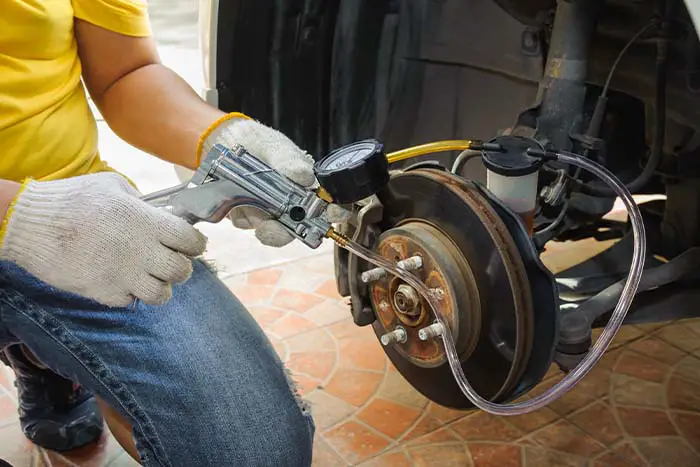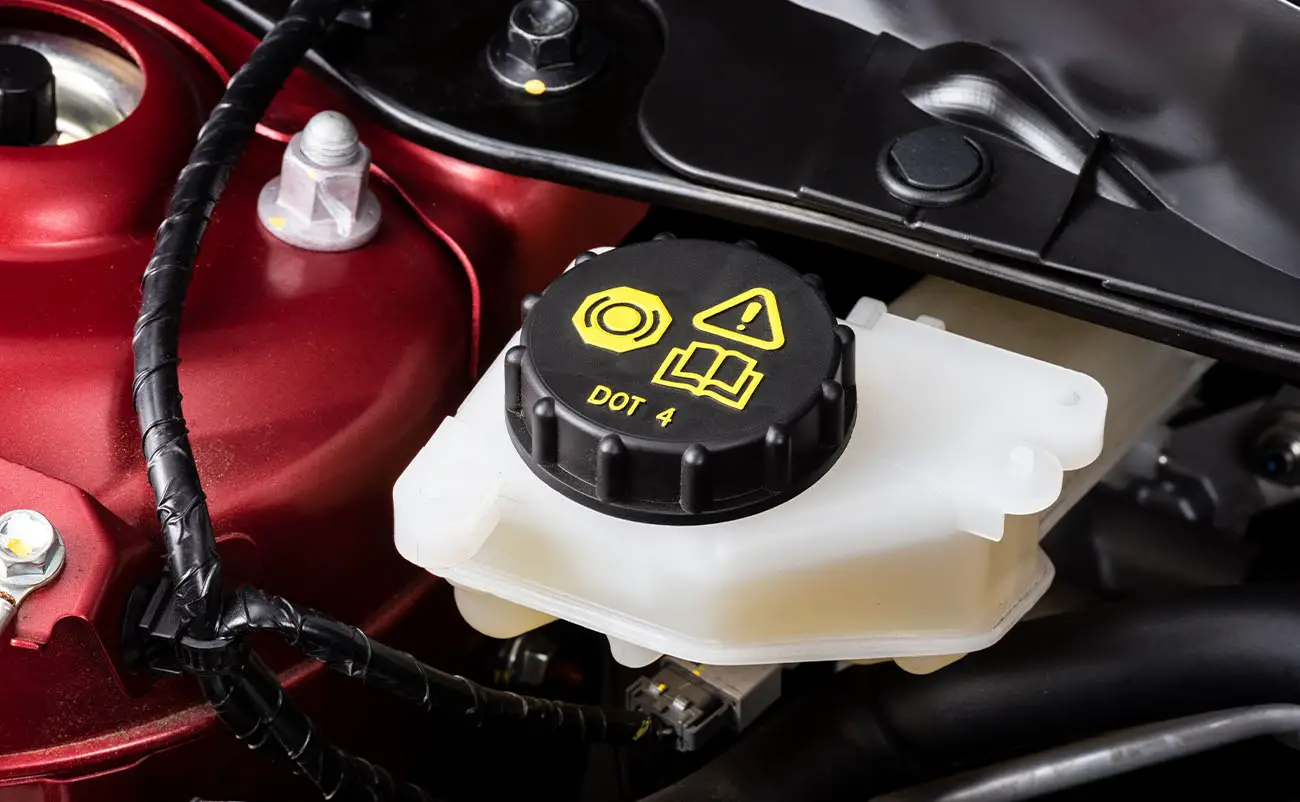Many people have no idea that their car’s brake fluid breaks down over time. Like your engine oil, your vehicle’s brake fluid needs to be changed — although not as frequently. While brake fluid changes can be performed regularly as part of preventive maintenance, there are also some signs you can watch for that signal the need for a fluid change. Thankfully, performing a brake fluid change is not an overly complicated task. Keep reading as we tell you when your vehicle needs to have the brake fluid changed and how to perform that change yourself.
Table of Contents
Steps To Perform A Brake Fluid Change

Performing a brake fluid change might sound like a difficult task, but it is not highly complex. A helper can make the job a little easier, but it’s not necessary as long as you have the right tools. Here are the steps you need to take to change the brake fluid in your vehicle.
#1. Remove Old Brake Fluid
First, you must remove the old brake fluid from the brake fluid reservoir. A suction pump or even a turkey baster works well for this task. Suction as much of the old fluid from the reservoir as possible. Once you’ve gotten out as much as possible, use a rag or paper towel to thoroughly remove the remaining fluid. Wipe down the inside of the reservoir to remove any dirt or debris that might be present. Remember that brake fluid is highly corrosive, so avoid getting any fluid on your vehicle’s paint. If you do, it should be cleaned immediately to avoid damage to the finish.
#2. Fill Reservoir With New Brake Fluid
Next, you’ll want to refill the brake reservoir with new fluid. Make sure that you use the type of fluid specified by your manufacturer in your owner’s manual. There are a few different types of brake fluid, and there are some significant differences in the performance of some fluids. Therefore, you should always follow your manufacturer’s recommendation, such as using DOT 3 or DOT 4 fluid. Fill the master cylinder reservoir up to the fill line with fresh fluid, and then you are ready for the next step.
#3. Bleed Brake System
At this point in the process, all your brake components still have old fluid in them. This includes your brake lines, brake calipers, and most other parts. Bleeding your system is what will push out the old fluid and replace it with the fresh fluid from the reservoir. This is where a helper can come in handy, but we’ll also discuss how to do this on your own.
Start with the wheel farthest away from your master cylinder. This will typically be the rear passenger wheel. Locate the bleeder screw on the brake caliper and attach a small vacuum hose that you can run to an overflow container. Have your helper gently press the brake pedal, and then you can loosen the bleeder screw. You should see brake fluid begin to flow out of the hose. Retighten the bleeder screw before your helper releases the brake pedal. Repeat the process of pressing the pedal and loosening the bleeder screw until you see new fluid coming from the valve and no air bubbles. You can then move to the next wheel until all four have been completed.
If you don’t have a helper, you’ll need a brake bleeder tool. This tool allows you to loosen the screw and suction the old fluid from the system without the need to press the brake pedal. Either way, you will want to keep an eye on the brake fluid level in the reservoir during the bleeding process. Make sure to keep it topped off with fluid as you bleed the system.
#4. Test Drive The Vehicle
Now that you have bled the system, it’s time to test drive the vehicle! You should first start the vehicle and press the brake pedal to make sure that everything feels normal. It should be firm and not go too far toward the floor. If everything seems normal, then start by making a stop from a slow speed. Once you have confirmed that the brakes work properly at low speeds, then you can increase your speed and perform a harder stop. You might not notice any improvement in your brake performance after a fluid change, but you want to ensure that performance has not decreased. If everything works as expected, then you are done! You just completed a DIY brake fluid change — an essential part of regular car maintenance!
Signs You Need New Brake Fluid
![]()
Like oil changes, brake fluid changes should be performed regularly. Typically, the maintenance schedule for a brake fluid change is every 30,000 to 45,000 miles or every three to four years. Some manufacturers, like Toyota, recommend fluid changes every two years. However, if you notice any of the following symptoms, it could be a sign that you need a brake fluid change right away. Here is what to watch for.
— Soft Or Spongy Brake Pedal
A soft or spongy pedal might signal that you need fresh brake fluid in your vehicle. Remember that brake fluid is hygroscopic. This means that the fluid absorbs moisture from the environment. Moisture in your brake fluid is not a good thing. Since brake fluid is a hydraulic fluid, it does not compress when placed under pressure. However, water does compress. The more moisture that enters your brake system, the softer the pedal will become. A soft pedal could also be a sign of low brake fluid. Either way, you should check your braking system right away to avoid any issues.
— Decrease In Braking Performance
Old fluid can lead to a decrease in your stopping distance and the performance of your brakes. The old fluid can cause contaminants to enter other parts of your brake system and cause damage. The fluid itself also loses some of its unique properties over time. As the fluid breaks down and absorbs moisture, it becomes less effective. If you notice a decrease in your braking performance, you should get your car to a professional mechanic. While a decrease in performance can also signal the need for new brake pads or brake rotors, you might also need fresh fluid in the system. If you do need new pads, brake pad replacement costs usually run anywhere from $300 to $500.
— Brake Light On Dash
The brake light on your dash is a clear sign of a problem. This could signal a malfunction with your car’s anti-lock brake system. The malfunction might be a result of old brake fluid. Corrosion from the old fluid can cause damage to ABS sensors and other parts of the anti-lock system. While you will likely need to replace the damaged sensor as well, you will want to go ahead and perform a brake fluid change at the same time. This will help prevent the new sensor from being damaged by the old fluid. An auto repair shop can help you pinpoint the specific problem and get everything running smoothly again.
— Strange Smells
Strange smells are usually a sign of a problem, and some weird smells are associated with brake problems. If you notice the smell of burning rubber, it could be your brakes overheating. Brake fluid has a very high boiling point because brakes get extremely hot during regular operation. However, if the fluid begins to boil, it will emit a smell like burning rubber. Once brake fluid has reached a temperature this high, it should be replaced immediately. While smells are usually bad, squeaking sounds don’t typically point toward a problem with the fluid. If your new brakes are squeaking, they might just need some adjustments.
Brake Fluid Change vs. Brake Fluid Flush
You may see some shops that advertise a brake fluid flush instead of a standard brake fluid change. So, what’s the difference between the two? The fact is that there is really no difference at all between a full brake fluid change and a brake fluid flush. Even when performing a total brake fluid change, you must thoroughly flush the old fluid from the lines through the bleeding process. This ensures that new fluid makes it to every part of the system.
You might find some shops that simply empty and refill the reservoir as part of a brake fluid change. In that case, there would be a difference between a fluid change and a flush. In that case, there would still be old fluid in the lines. Performing this type of fluid change is not advised as you are not truly replacing all the fluid in the system.
Cost Of Brake Fluid Replacement
You might be wondering how much it will cost to perform a brake fluid change. Thankfully, it is not an expensive car care item. Most shops will perform a brake fluid change for anywhere from $80 to $140. The specific amount depends on the make and model of your vehicle. Some high-end vehicles could cost you over $200, as they may require more labor time and more expensive brake fluid.
If you decide to do the work yourself, you can save yourself some money. Brake fluid usually only costs anywhere from $6 to $15 per quart, and you likely would not need more than two quarts of fluid to perform a full fluid change on your system. So, you might be able to complete the entire fluid change for less than $20 if you do the work yourself. It should only require an hour or two of your time, so it would very well be worth the effort if you have a little bit of mechanical experience!
The Bottom Line
Brake fluid changes are an important part of proper vehicle maintenance to keep your braking system operating at peak performance. Fluid changes generally only need to be performed every three or four years, and performing your own fluid change is not that difficult. Even if you have a repair shop perform the service, it should usually cost you less than $150. If your brake fluid is old and dirty, then go ahead and schedule a brake fluid change today!
Frequently Asked Questions
Is it really necessary to change brake fluid?
Yes, it is necessary to change brake fluid. While a fluid change is not necessary very frequently, old brake fluid becomes contaminated and absorbs moisture. Moisture and contaminants in your brake system are not a good combination! This can lead to a soft or spongy pedal as well as the malfunction of ABS sensors or other brake components. Keeping your fluid fresh and clean makes a big difference in braking performance and the longevity of your braking system.
How often does your brake fluid need changing?
For most vehicles, the brake fluid should be changed every 30,000 to 45,000 miles. If you do not drive your car very often, you should still change the fluid every three to four years. Some manufacturers, like Toyota, recommend more frequent changes. Toyota typically recommends a fluid change every two years or 20,000 miles. You should always follow your manufacturer’s recommendation when it comes to important vehicle maintenance, like brake fluid changes.
What happens if you don’t change brake fluid?
Since brake fluid is hygroscopic, it absorbs moisture from the environment over time. Too much moisture in the system can lead to corrosion on brake components as well as a soft brake pedal. This could increase your stopping distance, and it might cause you to end up in an accident. If you wait until the brake lines have rusted on the inside from the moisture, then you will likely also incur the cost of brake line replacement as well. Keeping your fluid changed at regular intervals is key to keeping all your brake components functioning properly.

